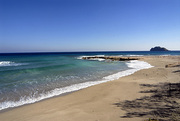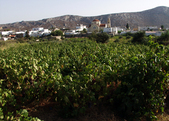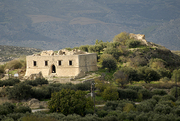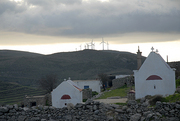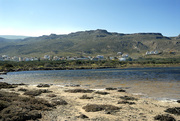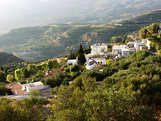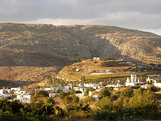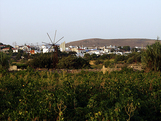The region of Lefki is in SouthEast of Crete. Ét has 2.435 population and the base of the region is the village of Ziros with 779 residents. It concludes the villages of Agia Triada, Apidia, Armenon, Ziros, Papagiannadon and Chandras.
Ziros is located in the north-eastern side of the plateau of Ziros, in an altitude of 590 m. Its pre-hellenic name serves as a testimony of its long history, along with the antiquities found in the area from different historical periods. Minoan remains have been located in five sites. The lovely Byzantine frescoes in the churches of Aghia Paraskevi, Aghia Eirini, Aghios Georgios and -most importantly- in Aghios Nikolaos, date back to the 14th - 15th century. In the church of Aghia Paraskevi the bones of the brave fighters from Skalia are sheltered. South from Ziros the small village of Aghia Triada (or Tso) is located, with a beautiful view of the Libyan Sea. In site of "Stalos" (an old little village) a Minoan settlement was excavated and in the site of "Leivari" there is the cave of Aligaras, which was inhabited during the Minoan period. After Ziros there is the village of Apidia, divided in small districts with a beautiful view of the Libyan sea. In the devastated settlement there are excellent architectural elements from the Byzantine, the Venetian and the Turkish period.
Armenoi
The village is located after Handras and before Etia. It is surrounded by gardens and fields, while the watermills that are preserved and function create a beautiful scenery. At the valley of Armenoi there is the church of Aghia Sofia, which used to belong to the notable monastery that flourished in older times, bearing the same name. The cave of the "Aghio Pneuma" (Holy Spirit) is also located in the area.
Voila
A deserted medieval settlement, one of the most notable of the period, 1 km north from the village of Handras. One of the most important monuments of the settlement is the church of Aghios Georgios and the ruined Venetian tower.Voila is the birth place of the Greek national poet, D. Solomos. There are also two wonderful fountains with spring water.
Etia
A small deserted settlement, west from the village of Armenoi. It was founded during the Byzantine period but flourished during the Venetian period when it was the feudal property of the family Dei Mezzo, who built the famous three-story villa. Today only the ground floor is preserved in a very good condition. The villa Dei Mezzo is considered the greatest private habitation of rural Crete and one of the most important buildings of its kind in south Europe.
Katelionas
Katelionas was one of the most populated villages of Sitia during the Venetian period. It is located on a plateau. Most of the houses are deserted today, including a well-built Venetian house, constructed during the first years of the 1820-1826 war. The archaeologist N.P. Papadakis relates the settlement with ancient Kastello. As he argued, the ancient epitaph incriptions and other findings indicate the existence of an ancient settlement in the area. Its name probably originates from the last name of its habitants, Katelos, an extended family from Nauplio that settled in Crete during the Venetian period, after the fall of Peloponnisos in 1479, mainly at the mountain chain of Lassithi.
Xerokambos
This important coastal settlement, south from Zakros, is located in a region inhabited since the Minoan period, according to archeological findings. At the coastal hill of Kefala a shrine was found, while in the site of Farmakokefalo parts of an important town are being excavated, which probably flourished during the Hellenistic period.
The significant findings from the excavations are exhibited in the Archeological Museum of Sitia and prove that the town had commercial relations with the islands of Karpathos, Rhodes and Kalymnos. The beaches of Xerokambos are considered as some of the most beautiful and pristine beaches of Eastern Crete.
Papagiannades
The settlement is first recorded in the 1834 Egyptian census Papa - Jannadho. At the hill of Ai Lias (Aghios Elias), 440 meters high, there was a shrine and in the site of Monastirakia the remains of a Minoan settlement were found. The name of the settlement is probably related to the surname of its first settlers. There is also a 14th century church of Panagia Eleousa with well-preserved frescoes.
Sykia
It is located 16,7 km away from Sitia, on the road from Papagiannades to Lithines. It is recorded in 1577 as part of the Sitia province by Fr. Barozzi. In1954, Nikolaos Platon excavated 17 tombs in the area between Sykia and Adramulon, dating back to the pre- Geometric, Geometric and Hellenistic periods. A large number of vessels, jewelry, iron weapons, stone stamps and other important findings were found in the area. During the 1897 revolution, the Turkish residents of the village were trapped in the local mosque and were burned alive by the rebels.
Handras
It is a central village on the fertile plateau of Handras. Old noble habitations and an interesting fountain are preserved in the village. Handras is constituted by the communities of Voila, Aghios Panteleimonas and Panteli, where the old frescoed church of "Metamorfosi tou Sotiros" is located. West from Handras there is the deserted settlement of Katelionas, which is full of ancient remains and ruins of old houses and churches. The cave "Panagia Gounta" is also located in the area.




